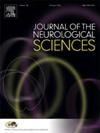纯运动起病的运动神经元疾病中认知/行为障碍的发展:我们能预测吗?
IF 3.2
3区 医学
Q1 CLINICAL NEUROLOGY
引用次数: 0
摘要
背景:大约50%的运动神经元病(MND)患者表现为认知和/或行为障碍(C/BI)。值得注意的是,虽然一些患者在发病时就表现出这些紊乱,但另一些患者在病程中出现这些紊乱,但这种现象的决定因素在很大程度上仍然未知。目的:本研究旨在确定脑卒中患者后续C/BI发展的基线预测因素。方法:纳入经爱丁堡纵向认知和行为ALS筛查(ECAS)的纯运动性MND病例(N = 80)。根据纵向数据,将患者分为两组,一组为剩余运动(“非转换者”,N = 55),另一组为发展中的C/BI(“转换者”,N = 25)。采用Mann-Whitney U检验和卡方检验比较两组人口统计学、遗传学、基线运动和认知/行为特征(以及相对进展率)。使用逻辑回归模型来确定C/BI发展的重要预测因素。结果:与非转换者相比,转换者在症状出现/首次就诊时的年龄更大(p = 0.02, p = 0.01),右肢发病频率更低(p = 0.02), ECAS交替(p = 0.01),拼写(p = 0.02)和流利字母S (p = 0.05)得分更低,以及更高的交替(p = 0.004)和拼写(p = 0.006)进展率,尽管这些对比在多次比较中没有校正。除拼写分数和进展率外,所有变量都能预测C/BI的发展(p从0.002到0.03)。讨论:虽然由于缺乏校正后的结果,无法得出确切的结论,但我们的研究表明,特定的临床特征可以显著预测MNDs中C/BI的发展。这些发现可能有助于早期识别有运动外症状发展风险的患者,从而实现更有针对性的临床管理。本文章由计算机程序翻译,如有差异,请以英文原文为准。
Development of cognitive/behavioral disturbances in motor neuron diseases with pure motor onset: can we predict it?
Background
Approximately 50 % of motor neuron disease (MND) patients manifest cognitive and/or behavioral impairment (C/BI). Notably, while some patients exhibit those disturbances from disease onset, others develop them during disease course, but the determinants of such phenomenon are still largely unknown.
Objectives
This study aimed at identifying baseline predictors of subsequent C/BI development in MNDs.
Methods
Pure motor MND cases with longitudinal Edinburgh Cognitive and Behavioral ALS screen (ECAS) exams were included (N = 80). Based on longitudinal data, patients were categorized as either remaining motor (“non-converters”, N = 55) or developing C/BI (“converters”, N = 25). Demographic, genetic, baseline motor and cognitive/behavioral features (with relative progression rates) were compared between groups using Mann-Whitney U and Chi-squared tests. Logistic regression models were used to identify significant predictors of C/BI development.
Results
Relative to non-converters, converters cases exhibited older age at symptoms onset/first visit (p = 0.02, p = 0.01), lower frequency of right limbs onset (p = 0.02), lower ECAS alternation (p = 0.01), spelling (p = 0.02) and fluency letter S (p = 0.05) scores, as well as higher alternation (p = 0.004) and spelling (p = 0.006) progression rates, albeit those contrasts did not survive correction for multiple comparisons. All variables except for the spelling score and progression rates were predictive of C/BI development (p from 0.002 to 0.03).
Discussion
While no firm conclusions can be drawn due to the lack of results surviving correction, our study suggests that specific clinical features significantly predict C/BI development in MNDs. These findings may facilitate an earlier identification of patients at risk for extra-motor symptoms development, enabling a more tailored clinical management.
求助全文
通过发布文献求助,成功后即可免费获取论文全文。
去求助
来源期刊

Journal of the Neurological Sciences
医学-临床神经学
CiteScore
7.60
自引率
2.30%
发文量
313
审稿时长
22 days
期刊介绍:
The Journal of the Neurological Sciences provides a medium for the prompt publication of original articles in neurology and neuroscience from around the world. JNS places special emphasis on articles that: 1) provide guidance to clinicians around the world (Best Practices, Global Neurology); 2) report cutting-edge science related to neurology (Basic and Translational Sciences); 3) educate readers about relevant and practical clinical outcomes in neurology (Outcomes Research); and 4) summarize or editorialize the current state of the literature (Reviews, Commentaries, and Editorials).
JNS accepts most types of manuscripts for consideration including original research papers, short communications, reviews, book reviews, letters to the Editor, opinions and editorials. Topics considered will be from neurology-related fields that are of interest to practicing physicians around the world. Examples include neuromuscular diseases, demyelination, atrophies, dementia, neoplasms, infections, epilepsies, disturbances of consciousness, stroke and cerebral circulation, growth and development, plasticity and intermediary metabolism.
 求助内容:
求助内容: 应助结果提醒方式:
应助结果提醒方式:


